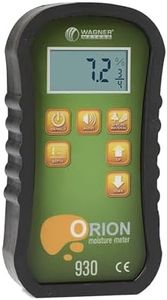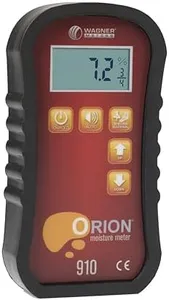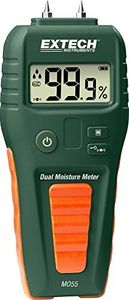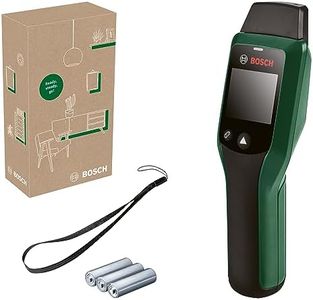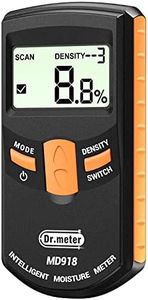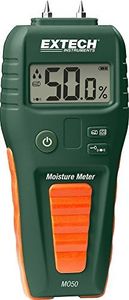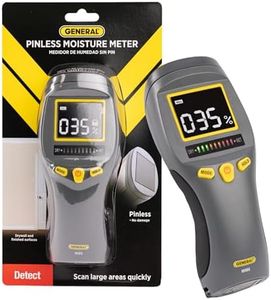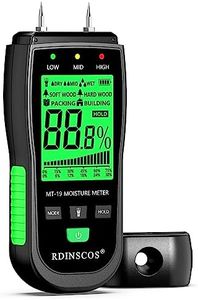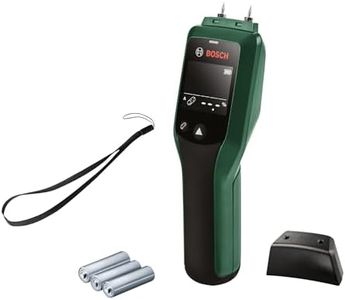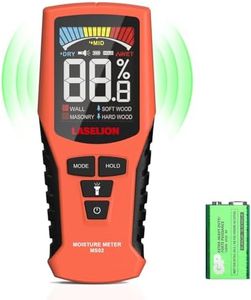We Use CookiesWe use cookies to enhance the security, performance,
functionality and for analytical and promotional activities. By continuing to browse this site you
are agreeing to our privacy policy
10 Best Moisture Meter For Firewood
From leading brands and best sellers available on the web.Buying Guide for the Best Moisture Meter For Firewood
Choosing a moisture meter for firewood is important if you want to ensure safe and efficient burning. Firewood that is too wet can be hard to light, produce more smoke, cause creosote buildup in chimneys, and burn less efficiently. A good moisture meter helps you check when your wood is ready to use. When picking a moisture meter, it's important to consider how it measures, how easy it is to use, and how reliable its readings are. Focusing on these aspects will help you find a device that makes checking your firewood quicker and more accurate.Measurement Type (Pin vs Pinless)Moisture meters come with either pins that you insert into the wood, or sensors that scan from the surface (pinless). Pin meters measure moisture between the inserted probes and are generally more precise for checking the inside of firewood. Pinless meters use sensors and can check a larger area quickly without leaving marks but may be less accurate with irregular shapes or very thick logs. If you typically split your firewood or want very accurate readings, a pin meter may be best. If you want fast scans and don't mind a slight loss in precision, consider a pinless model.
Measurement RangeThis spec tells you the minimum and maximum percentage of moisture that the meter can detect. For firewood, the critical range is usually from about 6% (very dry wood) to 40% or more (freshly cut, very wet wood). Choosing a meter with a range that covers at least 10-40% ensures you'll catch both green and seasoned wood. If you only burn well-seasoned wood, a narrower range may be fine, but most users benefit from a wider range to handle different types and ages of wood.
AccuracyAccuracy describes how close the meter's reading is to the wood's actual moisture content. Higher accuracy means you'll have more confidence that your firewood truly is dry enough. Meters generally list their accuracy as plus or minus a certain percentage, such as ±1%. If you're using the meter to meet specific burning or stove guidelines, look for higher accuracy. If you only need a rough idea whether wood is wet or dry, a little less precision may be okay.
Readability (Display and Interface)This refers to how easy it is to read and understand the meter's results. Look for a clear, easy-to-read display—especially if you'll be using it outdoors or in dim lighting where you might need a backlit screen. Simple button layouts and clearly labeled readings also matter, especially if you want to use the meter quickly without checking instructions each time. If you prefer a more intuitive experience, prioritize meters with larger screens or straightforward controls.
Durability and Build QualitySince you'll likely use the moisture meter around woodpiles, outdoors, and in different weather, durability is key. Check for solid construction, protective covers for pins, and some resistance to water or dust. If you expect rough use or want the meter to last several seasons, pick one that feels sturdy and is rated for outdoor work. Lighter, less rugged meters may be fine for occasional indoor use.
Calibration and AdjustabilitySome moisture meters let you calibrate for different wood types, which helps improve accuracy since various species meter differently. Built-in calibration or the ability to adjust readings for hardwoods versus softwoods is a plus if you use many wood types. If you always use a single type of wood, this might not matter as much, but for varied firewood, adjustability ensures more reliable readings.
